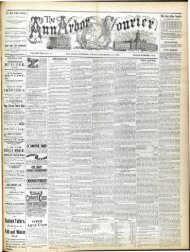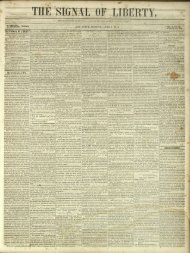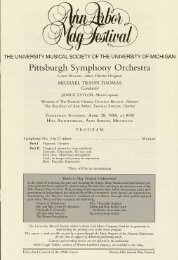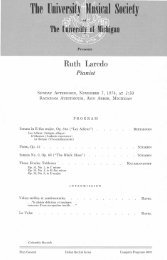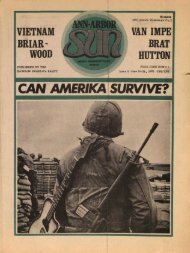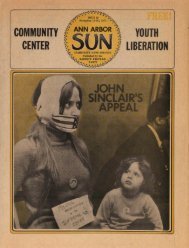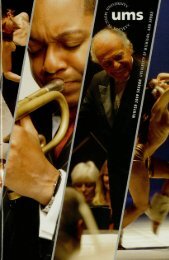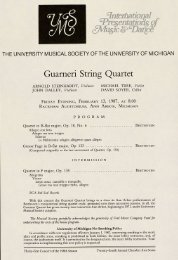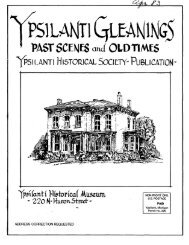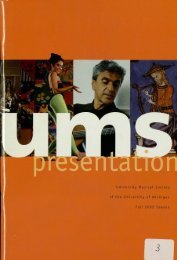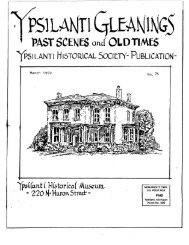TIImm i
TIImm i
TIImm i
Create successful ePaper yourself
Turn your PDF publications into a flip-book with our unique Google optimized e-Paper software.
OMDVEffiSBTTV SWSI(§M SOCIETY<br />
TII mm i<br />
FIRST SEASON SECOND CONCERT<br />
No. CCCXXXIV COMPLETE SERIES<br />
THE NEW YORK CHAMBER MUSIC SOCIETY, INC.<br />
CAROLYN BEEBE, Director<br />
PIERRE HENROTTE, First Violin<br />
HERBERT SOMAN, Second Violin<br />
SAMUEL LIFSCHEY, Viola<br />
PAUL REFER, Violoncello<br />
E3IIL MIX, Double Bass<br />
ARTISTS<br />
CAROLYN BEEBE, Pianoforte<br />
GUSTAVE LANGENUS, Clarinet<br />
WILLIAM KINCAID, Flute<br />
HENRI DE BUSSCHER, Oboe<br />
UGO SAVOLINA, Bassoon<br />
JOSEPH FRANZL, French Horn<br />
IH1BLL MJlITOMi, AKIN<br />
MODOOAV, OEGEMIEIR US, 119110, AT E«T rGlOGK<br />
PROGRAM<br />
QUINTET FOR PIANOFORTE, CLARINET, OBOE, FRENCH HORN, AND<br />
BASSOON, E flat major, Op. 16<br />
Grave—Allegro ma non troppo; Andante cantabile;<br />
Allegro ma non troppo<br />
OUINTET FOR CLARINET AND STRINGS, B minor, Op. 115<br />
Beethoven<br />
(1770-1827)<br />
Brahms<br />
(1833-1897)<br />
Allegro ; Adagio : Andantino—Presto non assai; Con moto<br />
"FIVE IMPRESSIONS OF A HOLIDAY" (Cinq Impressions d'un Sejoar a la<br />
Campagne) FOR PIANOFORTE, FLUTE, AND VIOLONCELLO, Op. 7<br />
Bugene Goossens<br />
(1893—)<br />
IN THE HILLS (Parmi les collines)<br />
THE WATER-WHEEL (Le petit moulin a eau)<br />
BY THE RIVERS (Le long des rivieres)<br />
THE VILLAGE CHURCH (Ueglise du village)<br />
AT THE FAIR (A la vogue)<br />
SINFONIA DA CAMERA FOR PIANOFORTE, STRINGS, FLUTE, OBOE, CLARINET,<br />
BASSOON, AND FRENCH HORN, B flat major, Op. 8 . Wolf-Ferrari<br />
Allegro moderato; Adagio; Vivace con spirito; i 1 ^?^ )<br />
Finale; Adagio—Allegro moderato<br />
The next concert in the MATINEE MUSTCALE SERIES will be Riven by the YPSILANTI<br />
NORMAL CHOIR, TUESDAY EVENING, DECEMBER 16, 1919 in St. Andrew's<br />
Episcopal Church.<br />
The next concert in the CHORAL UNION SERIES will be Riven by RICCARDO STRAC-<br />
CIARI, BARITONE, THURSDAY EVENING, JANUARY 15, 1020.<br />
The next concert ni the EXTRA CONCERT SERIES will be Riven by MISCHA LEVITZ-<br />
- KI, PIANIST, FRIDAY EVENING, JANUARY 23, 1920.<br />
TRAFFIC REGULATION.—By order of the Police Department, on the niRhts of Concerts,<br />
vehicles of all kinds will be prohibited on North University Avenue between Thayer and<br />
InRalls Streets; Taxi-cabs must park on the West side of Thayer Street, facing South between<br />
North University Avenue and WashinRton Street; Private autos may be parked on<br />
InRalls and WashinRton Streets. Persons onfoot are requested to refrain from leaving from<br />
the Taxi-cab entrance at the Thayer Street side of the Auditorium,<br />
SPECIAL INTERURBAN CARS. — East for Detroit and West for Jackson and intervening<br />
points will leave the Auditorium immediately after all concerts.<br />
LOST ARTICLES should be enquired for at the office of Shirley W. Smith, Secretary of the<br />
University, in University Hall, where articles found should be left.
ANALYSES<br />
QUINTET FOR PIANOFORTE, CLARINET, OBOE, FRENCH HORN AND<br />
BASSOON, E flat major, Op. 16 Beethoven<br />
Grave—Allegro ma non troppo; Andante cantabile;<br />
Allegro ma non troppo<br />
Ludwig van Beethoven was born at Bonn, December 16. 1770;<br />
died at Vienna, March 26, 1827<br />
This work, written for an unusual combination of instruments and first produced at a<br />
concert of Schuppanzig's on April 6, 1797, was a product of the winter of 1796. Beethoven<br />
had already written a Trio, Op. 11 (published Oct. 3, 1706), in which the clarinet was substituted<br />
for the violin, and the Quintet on our program is an extension of his instrumental<br />
scheme indicative of his fondness for wind instruments, a fondness further displayed in his<br />
Septet, Op. 20, and a Sonata for French-horn, written in this period.<br />
In the following analysis of the work only important features are noted.*<br />
The introduction—E flat major, Grave, Common time—with its majestic opening theme<br />
in unison and its interplay of resulting motifs, leads into the first movement proper—Allegro<br />
ma non troppo, 3-4 time. In this, the first theme, 16 measures in length, is stated by the<br />
pianoforte after which it is taken up by the clarinet, the oboe joining in the last 8 measures.<br />
Continuing in terms of the first theme for 38 measures it then modulates into the second<br />
subject—B flat major—which, with the coda, covers 85 measures. The "development" section<br />
(84 measures) with its logical illustrative processes, leads to the reappearance of the<br />
principal subject. After this the composition runs the course ordained by the canons of the<br />
sonata-form in which it is cast.<br />
The second movement—B flat major, Andante cantabile, 2-4 time—opens with a theme<br />
almost Mozartian in its simplicity and charm. It is first set forth by the pianoforte and<br />
completed by the clarinet. The oboe then introduces a short theme, in G minor, which is<br />
further developed by the bassoon. Following this, the clarinet again dominates the woodwind<br />
group and the principal theme, somewhat varied, enters for the last time and unfolds<br />
itself along the lines of its first appearance. Following a beautiful theme, beginning in B<br />
minor and ending in D flat major, given out by the horn, the principal theme makes its final<br />
appearance. It is subjected to a very elaborate variation, leading to the coda.<br />
The Rondo—E flat major, Allegro ma non troppo, 6-8 time—the third movement—is<br />
easy of comprehension if one carefully observes the first 8 measures—for, as implied by the<br />
term "rondo", this theme constantly reappears after each of the secondary themes is heard.<br />
First published in 1801, the Quintet is now listed in Series 10, of Beethoven's Complete<br />
Works, Breitkopf and Hartel.<br />
QUINTET FOR CLARINET AND STRINGS, B minor, Op. 115 . . Brahms<br />
Allegro; Adagio; Andantino—Presto non assai; Con moto<br />
Johannes Brahms was born at Hamburg, May 7, 1833;<br />
died at Vienna, April 3, 1807.<br />
Certain worshippers of Brahms, who omit the "s" in spelling his name, have attempted<br />
to create the impression that he was more godlike than human. He may have exhibited<br />
certain traits on which this type of admirer might base such an assumption, but, as a matter<br />
of fact, he was intensely human, in no respects more so than in his sense of humor and his<br />
love of justice. Two of his sayings illustrate these qualities. Speaking of a composition by<br />
a then prominent "All Highest" he said: "You must never criticise the music of royalty;<br />
you do not know whom you are criticising." Again, referring to certain ill-natured remarks<br />
by Wagner, he said: "Wagner has the great highway! why will be not leave me my narrow,<br />
little lane?"<br />
*The analyses in this program have been made possible through the courtesy of the<br />
Library of Congress and Mr. O. G. Sonneck, G. Schirmer and Co., who loaned scores otherwise<br />
inaccessible.
Brahms, like Beethoven, had a peculiar fondness for the clarinet as is shown by the fact<br />
that this Quintet, written in 1892, was preceded by the Trio in A minor for pianoforte, clarinet,<br />
and violoncello. Op. 144 (also written in 1892) and followed (in 1895) by two Sonatas for<br />
pianoforte and clarinet—in F minor, and E flat major, Op. 120. His warm personal friendship<br />
for Professor Miihlfeld (Meiningen), a remarkable clarinet virtuoso, may have influenced<br />
him in this, but the powerful appeal of the instrument itself would be sufficient reason<br />
for his choice.<br />
^ In the composition on our program, as in all his chamber music, Brahms shows his art<br />
at its best and incidentally throws doubt on the narrowness of his "little lane."<br />
The first subject of the opening movement of the Quintet—B minor, Allegro, 6-8 time—<br />
with its initial phrases in thirds, is in a less vigorous strain than the second. This is a decided<br />
lapse from convention but justifies the inherent plasticity of form when it serves<br />
rather than dominates. It is impossible to point out the interplay of motifs, or to analyse<br />
the structural processes displayed in this movement without citations in actual notation,<br />
therefore it will not be attempted. Failing such citations the only alternative would involve<br />
so many technicalities that it would result in confusion to the layman and be of no service<br />
to the trained musician. The combination of concentration and a creative mood will yield<br />
infinitely more than the perusal of a labyrinth of technical terms.<br />
In the second movement—B major, Adagio, 3-4 time—the honors lie with the clarinet<br />
In the first division, of 51 measures, its warm and sympathetic tone-quality in cantabile will<br />
be revealed, while in the sections intervening between this and the reappearance of the principal<br />
subject the elaborate passages assigned the instrument will no less clearly show its<br />
adaptability to virtuoso treatment. Did these sections do no more than this they would be<br />
of interest, but they are full of musical beauty and furnish a delightful contrast.<br />
The third movement—D major, Andantino, Common time—opens with what J. Fuller<br />
Maitland calls "A square-cut theme". After the first 8 measures the clarinet is joined by the<br />
first violin in its statement of this, the principal theme. At the 34th measure another division—B<br />
minor, Presto non assai, ma con sentimento, 2-4 time—enters and continues in<br />
terms of its conditioning theme until 9 measures from the end, when the clarinet again<br />
gives out the initial melody of the movement. Throughout this section the clarinet and first<br />
violin appear to be engaging in an interesting conversation. We may not know its import<br />
but its beauty of utterance is apparent.<br />
The last movement—B minor, con moto, 2-4 time—is made up of five variations built<br />
on a lovely theme in which each phrase after being given out by the strings is echoed by the<br />
clarinet. In the final coda the opening theme of the first movement again appears and knits<br />
the whole work together in a unity characteristic of the style of a genius whose mastery of<br />
form is in evidence from his simplest song to his greatest symphony.<br />
This Quintet was published in 1892.<br />
"FIVE; IMPRESSIONS OF A HOLIDAY" FOR PIANOFORTE, FLUTE, AND<br />
VIOLONCELLO, Op. 7 . . . . Eugene Goossens<br />
IN THE HILLS BY THE RIVERS<br />
THE WATER-WHEEL THE VILLAGE CHURCH<br />
AT THE FAIR<br />
Eugene Goossens was born at London, May 26, 1893; still living.<br />
Eugene Goossens and Lord Berners (Gerald Tywhill) are instanced by Ernest Newman<br />
as "The two chief representative modernist composers in England who succeed best of all<br />
in that attempt to translate into music by means of a subtle realism those visualized effects"<br />
which Mr. Newman considers "the main object of music today."<br />
In considering the above deliverance of Ernest Newman it may be pointed out that the<br />
instrumental literature contains many examples of impressions similar to those embodied<br />
in the selections recorded above. The essential difference between Schumann's "Scenes of<br />
Childhood," MacDowell's "Sketches" and "Woodland Suite" and those on this evening's<br />
program, lies in the means through which they arrive at the "subtle realism."<br />
As the score is inaccessible reliance must be placed on the suggestions of the titles of<br />
the various numbers rather than on formal analyses of their meanings. The following<br />
enumeration of keys, tempo-marks, etc., may, however, be of some service.<br />
(I) E flat major (?), Moderato, 3-4 time; (II) A major, Tranquillo, 2-4 time; (III)<br />
E flat major, Con moto e leggiero, 2-4 time; (IV) D flat major, Andante con moto, 3-4<br />
time; (V) C major (?), Scherzando, 3-8 time.<br />
"Five Impressions of a Holiday" was published in iQifi.<br />
In pre-modernist compositions the determination of the key presented no difficulty, but<br />
npw-a-days the signature frequently functions as a species of tonal camouflage concealing<br />
such a redundance of tonalities, harmonic schemes^ and metrical irregularities as to warrant<br />
the assumption that eventually the necessities of this "subtle realism" will lead to the abandonment<br />
of all signatures.
SINFONIA DA CAMERA FOR PIANOFORTE, STRINGS, FI,UI% OBOE, CLARINET,<br />
BASSOON AND FRENCH HORN, B flat major, Op. 8 . Wolf-Ferrari<br />
Allegro moderato; Adagio; Vivace con spirito;<br />
Adagio—Allegro moderato<br />
Ermanno Wolf-Ferrari was born January 12, 1876, at Venice;<br />
still living.<br />
The combination of instruments and the implications of the title of this unusual example<br />
of a genre the possibilities of which are not always realized, remove the imminent dangers<br />
attending any attempt to extend the range of chamber-music forms. The majority of<br />
compositions in which the number of instruments exceeds four have been written for strings.<br />
The loss of the individuality we find in the string-quartet, in such cases is not made good<br />
by the added color and sonority of the orchestra. Bearing in mind the creative power of<br />
Wolf-Ferrari we are justified in assuming that he has struck a happy medium. If so, it may<br />
be considered a prophecy of still other similar attempts in the future, but, judging by the<br />
past, and present, one may be forgiven for contemplating such a future with somewhat of<br />
reserve.<br />
From the very beginning of his career Wolf-Ferrari has been singularly independent of<br />
convention and tradition. He has introduced many novel features in his use of the orchestra<br />
and chorus. To prove this one may cite "La Vita Nuova". In this work his use of 7 kettledrums<br />
as melodic factors and the interjection of the pianoforte^ and the chorus into the<br />
orchestral mass thereby winning novel "color", indicate a new point of view and a decided<br />
addition to the resources of composers.<br />
The independence for which Wolf-Ferrari is noted is displayed in the work on our<br />
program in no respect more than in its rhythmical freedom. Again, any attempt to apply<br />
traditional standards to his interpretations of the form suggested by the title Sinfonia<br />
will show conclusively that he so freed himself from hampering restrictions as to make a<br />
close analysis difficult, if not impossible.<br />
In the first movement — B flat major, Allegro moderato, Alla-Breve time — heralded<br />
by pulsating chords for the pianoforte, pianissimo, a broad, song-like melody for the<br />
clarinet is heard. At the 22d measure it runs into the key of G minor and is supplemented<br />
by the pianoforte, while the viola and the violins play contrasting figures. After many measures<br />
in G minor, a new, broadly sustained theme enters which leads to a repetition of the<br />
first theme with an intensified treatment. The next theme demanding attention is set forth<br />
by the French-horn—F major, tranquillo-—and its basic motif furnishes the material for<br />
many and varied future thematic relationships. Still other themes are introduced as the wellknit<br />
movement runs its course, but those cited are the most important. The rhythmical and<br />
interpretative freedom already pointed out is illustrated by the frequent alternations of<br />
ritardando, accelerando, piu mosso and maw mosso with which the score bristles. The<br />
effect produced is somewhat akin to the rubato style, but greatly enhanced.<br />
The characteristics noted in the preceding paragraph dominate the structure of the second<br />
movement—C sharp minor, Adagio, 6-8 time. In the first 16 measures we find the following<br />
time-signatures:—6-8; 5-8; 4-8; 3-8; 4-8; 3-8, while the tempo-marks display as<br />
great a variety. But, that they are abundantly justified is proved by the elasticity and delicacy<br />
of the principal motifs, and their varied character. Possibly, of the instruments employed,<br />
the bassoon, which opens the movement, carries the honors, although the "strings" and the<br />
other combining instruments are given opoprtunity to display their possibilities both in solo<br />
and as members of the ensemble.<br />
The third movement—G flat major, Vivace con spirito, 3-4 time—after a short introduction<br />
(5 measures) brings a figure for flute which is the basis of a beautiful theme'—<br />
Allegretto con grazia. This theme is the conditioning factor in the whole movement.<br />
The Finale—D minor—B flat major, Adagio-Allegro moderato. Common time—is full<br />
of vi^or and exhibits many of the characteristics already noted. Adagio followed byAllegro<br />
moderato is much in evidence and other minor changes of tempo are frequent. This elasticity<br />
of tempo characterizes the first 55^measures which lead to a lovely horn solo—Andante<br />
mosso, due voltt piu lenio-accel. which is broken in upon by an agitated section—Piu mosso<br />
e accel. This continues until it gives way to the melody which, as played by the horn, must<br />
have lingered in the memory. Proceeding with masterly developments of themes already<br />
heard, and still other contrasting and logically conditioned material, the work comes to a<br />
forceful conclusion, reminiscences of thematic material heard in the first movement preceding<br />
the final chords.<br />
According to anote on the last page of the score the work was finished in March, ioor,<br />
and was published in 1903.<br />
The modern concept of a tonality in which whole tonalities are included in an all-embracinp*<br />
tonality one may designate as amni-tonic; a similar inclusion of simple rhythms in an<br />
omni-rhvthmical scheme; the more insistent stressing of dynamic effects coupled with greater<br />
variety and intensity of orchestral color, are some of the legitimate results of the desire to<br />
attain "subtle realism". In some cases, as in d'Indy's recent symphony De Bello Galileo<br />
this realism is brutal.<br />
THE ANN ARDOR PREM




